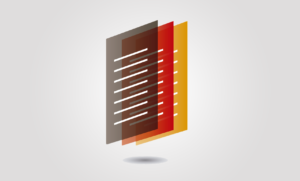By Ernesto Spinak

Image: Kreativkolors / Freepik.
Unlike historical revisionism where “the past turns out to be unpredictable”, it is assumed that scientific research builds on cumulative revisions and it is the future that is unpredictable.
Society hopes that scientific knowledge is be based on reliable research and credible results, led by teams of professionals governed by ethics codes and proven experimental protocols. It is a scientific knowledge characteristic, the ability to predict results. It is logical to expect that new discoveries modify previous knowledge, extend it, and even sometimes refute it completely. It’s in the mechanics of things.
In the research process errors may occur, or incomplete results or without the necessary precision may be offered, or whose conclusions are not duly substantiated. The pressure to publish and prioritize results often conspires against greater accuracy and transparency in research, and sometimes, regrettably, there are frauds, data manipulation, plagiarism, and other unethical practices. But they are few. That is why there is peer review, editorial control, ethical norms and a whole series of procedures that have been elaborated by consensus for decades. One of these procedures is related to the recognition of errors in articles already published, and how they are modified or canceled, and how to inform the scientific community to take due note.
The traditional system of scientific publishing emerged from the paper world ended in an article published in a journal that, with exceptions, was considered as the end point of the process, something static that would rarely be changed and that would eventually be cited by other researchers. When the need arose for corrections or retractions of a published article, a long and complex process began that could last for a year or two, until finally a note was published in the same journal or sometimes in another journal. However, the scientific community was not always aware of this eventuality and the original article with errors could still be cited in its original version.
The traditional system of scientific journals publishing does not encourage researchers to make necessary post-publication changes to an article, even if it is recommended and acting in good faith. Moreover, publishing change notes under the label “retractions” is resisted by the authors, as the term includes many shades ranging from insignificant, important, or complete changes to severe retractions, plagiarism, data fabrication, and bad faith.
Fortunately, this editorial landscape is no longer the real picture, it is rapidly entering obsolescence and must be changed. Nowadays, with preprints servers, DOI, pre and post-publication peer review, as well as open access text and data, the scientific communication landscape is taking a Copernican turn. As commented in an earlier post1 scientific journals will be the stable stage of a dynamic and recursive process of publication, where articles will not necessarily be closed. The articles could be in beta version for a long time (like the Google search engine, which has nothing wrong with it).
This is how four authors affiliated to COPE, Crossref and BioMed Central just published on the week of March 20, 2017 a preprint2 in bioRxiv that spikes the scalpel at the very center of the problem and suggests a general and effective solution that modernizes the dynamics of publications and its subsequent modifications to the stature of the best state of the art.
The central idea of the authors is that one must be aware that a published article does not have to remain unchanged and static forever. Also, the COPE manuals in its latest version of 20093 on retractions do not reflect the different situations, since the same terminology used in this manual assumes that changing something is a kind of admission of guilt.
Consequently, it is necessary to generate a new nomenclature and to implement simpler and shorter procedures that correctly link the bibliographic references to the articles in their last available version, with their possible corrections, and from this version, generate the chains of links with the previous versions. All this is done using an intelligent DOI modification with a Crossref application4. This practice would make it possible to record bibliographic references accurately in a way that has never been possible before. Researchers could cite the latest version of an article or, if they wish, an earlier version, regardless of whether it is a preprint, postprint or an institutional copy, original or corrected. And this proposal is not only for the articles, it can also extend to the registered protocols of experiments, and to open access datasets.
The authors of the article propose a model where the term “retraction” and its synonyms are replaced by a general term of neutral semantics, or “amendment” and in turn establish a typology of amendments with different scales and effects in the message with the following written metadata:
- General statement indicating “The author and/or the journal wish to make the following amendments to the following published article [reference]”.
- Type of amendment: (based on the following scale)
- Non-substantive (errata, typographical error, etc.)
- Substantive: corrections, parts that are substituted, authorship, addition of evidence
- Complete: the article in its current form should be changed, which includes, in addition, retractions.
- Elements of the amendment
- Who makes the correction, the author, the editor, the institution, etc.
- Type of amendment referred to the previous scale
- Link to the publication being amended and other relevant links associated
- Date
- Scope notes
The procedure from the journal editor is very straightforward and can be done in a short time. The model analyzed in the mentioned article compares the current process recommended by COPE (two years) with the time required with the new model that is estimated at 3 months, depending on the journal periodicity. It is recommended to see the example in the cited article2 on pages 8-11.
The other part of the recommended template is related to online presentation to the public and links using the DOI strings.
Although each publisher uses its own design for content presentation, the article suggests the following implementation:
- Each amendment should link to the article it modifies, and vice versa.
- Article versioning: Each successive version of the article must have its own DOI, as well as a persistent URL, and articles should indicate the date of the release. When an article is linked directly to the homepage in a journal, this link should point to the latest version.
- General amendments: Amendments must be linked in the order in which they are published. This includes not just the articles but the figures and other elements of the article.
- DOI (construction): Here is another of the innovative ideas. Although DOIs can be linked through CrossRef to determine the relationship between versions, it is suggested to add suffixes to DOI numbers to make it evident to the human eye.
Example: doi.org/10.1136/bmj.j1072.1; doi.org/10.1136/bmj.j1072.2, etc.
- DOI (resolution): each DOI should be directly linked to the corresponding version.
This modification of the metadata structure will require that the publishing and indexing systems make the necessary modifications to reflect the new structures. All metadata should have open license to propagate in different interfaces and formats. These requirements can be solved with the already available technologies.
My opinion
Online scientific communication under the open access paradigm, preprints servers, and open peer review requires procedures that are ideologically and technologically distinct from the traditional methods inherited from paper. Published articles might not be stable for all eternity. Corrections, errors, amendments and any other modifications should leave their marks on the way and the scientific community must have the means to follow the trail in a quick, simple and efficient way.
This methodological advancement represents a new challenge to SciELO, but as it has been demonstrated for the past 19 years, the SciELO Program has always been in the most advanced line betting on modernization.
Notes
1. SPINAK, E. What’s the deal with preprints? [online]. SciELO in Perspective, 2016 [viewed 25 March 2017]. Available from: http://blog.scielo.org/en/2016/11/22/whats-the-deal-with-preprints/
2. BARBOUR, V., et al. Amending published articles: time to rethink retractions and corrections? [online] bioRxiv. 2017. [viewed 25 March 2017]. DOI: 10.1101/118356. Available from: http://biorxiv.org/content/early/2017/03/24/118356
3. Committee on Publication Ethics Retraction Guidelines [online]. Committee on Publication Ethics (COPE). 2009 [viewed 25 March 2017]. Available from: http://publicationethics.org/files/retraction%20guidelines.pdf
4. Crossmark [online]. CrossRef. 2017 [viewed 25 March 2017]. Available from: https://www.crossref.org/services/crossmark/
References
BARBOUR, V., et al. Amending published articles: time to rethink retractions and corrections? [online] bioRxiv. 2017. [viewed 25 March 2017]. DOI: 10.1101/118356. Available from: http://biorxiv.org/content/early/2017/03/24/118356
Committee on Publication Ethics Retraction Guidelines [online]. Committee on Publication Ethics (COPE). 2009 [viewed 25 March 2017]. Available from: http://publicationethics.org/files/retraction%20guidelines.pdf
Crossmark [online]. CrossRef. 2017 [viewed 25 March 2017]. Available from: https://www.crossref.org/services/crossmark/
SPINAK, E. What’s the deal with preprints? [online]. SciELO in Perspective, 2016 [viewed 25 March 2017]. Available from: http://blog.scielo.org/en/2016/11/22/whats-the-deal-with-preprints/
 About Ernesto Spinak
About Ernesto Spinak
Collaborator on the SciELO program, a Systems Engineer with a Bachelor’s degree in Library Science, and a Diploma of Advanced Studies from the Universitat Oberta de Catalunya (Barcelona, Spain) and a Master’s in “Sociedad de la Información” (Information Society) from the same university. Currently has a consulting company that provides services in information projects to 14 government institutions and universities in Uruguay.
Translated from the original in Spanish by Lilian Nassi-Calò.
Como citar este post [ISO 690/2010]:












Read the comment in Spanish, by Javier Santovenia:
http://blog.scielo.org/es/2017/03/31/yo-escribi-eso-yo-no-escribi-eso-ahora-escribo-otra-cosa/#comment-40924